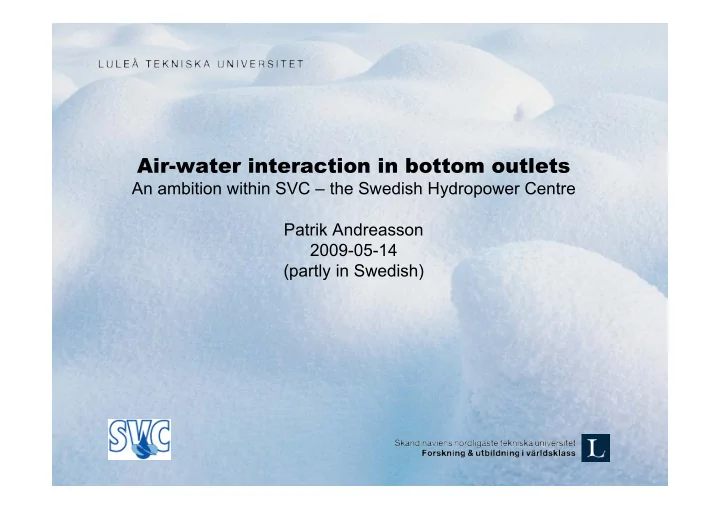

Air-water interaction in bottom outlets An ambition within SVC – the Swedish Hydropower Centre Patrik Andreasson 2009-05-14 (partly in Swedish)
Svenskt Vattenkraftscentrum • Vattenturbiner och generatorer • Vattenbyggnad Vattenbyggnadshydraulik: - 2 miljöer: KTH och LTU, samarbete med CTH prioriterat - Miljö = Seniorforskare + 3-4 doktorander - Etableras 2009-2012 - Fokus på bottenutskov initialt - Probleminventering: SWECO 2007-12-19
Bottenutskov – tvåfasfokus Praktiska frågeställningar: • Luftmedrivning • Luftblåsning • Modelleringsverktyg för frivattenströmning och luftinblandning Fokus LTU (OBS prel. tankar): • Luftinblandning och avluftning – Tvåfas: modellering av fri vattenyta, bubbeldynamik, val av tvåfasansats – Fokus/mål på ingenjörsmodellering, d.v.s. subgridmodeller för RANS – I första hand tillämpning och validering, ej modellutveckling – Möjlig fördjupning: modellering av fri v.y. i regimer från “weak” till “strong turbulence” – Fokus vattensprång – Skaleffekter – Samverkan med KTH och CTH • Modellering av luftblåsning – Kräver validering i utskovsrigg
Hydraulic jump • Fr > 1 to Fr < 1 • Substantial energy dissipation • Role in hydro: dissipate kinetic energy from spillways • Why: Control - safety, erosion, cavitation • Classical Civil Engineering: Momentum & Continuity, empirical relations • Present design-tool: Physical modelling (trust in results) L d 2 d 1
Hydraulic jump From Chanson & Gualtieri (2008)
From Gualtieri & Chanson (2007) Physical hydraulic models Froude scaling: gravity forces are scaled correctly λ = L p /L m , Typically λ = 50 U m = λ -1/2 U p Re m = λ -3/2 Re p We m = λ -2 We p Re number and We significantly reduced: • Re-effects small (remains essentially fully turbulent rough) • We-effects substantial (surface tension forces inhibits destabilisation by inertial forces)
Fr c We c From Brocchini & Peregrine (2001)
From Brocchini & Peregrine (2001)
More reading: SVC – Swedish Hydropower Centre: http://www.svc.nu/ Bottom outlets – review of problems in Sweden: • Dath, J. and M. Mathiesen, 2007, “Förstudie hydraulisk design – Inventering och översiktlig utvärdering av bottenutskov i svenska dammanläggningar”, Slutrapport, Stockholm 2007-12-19, Uppdragsnr. 2165545, Sweco VBB AB. Hydraulic jumps: • Murzyn, F. and H. Chanson, 2008, “Experimental assessment of scale effects affecting two-phase flow properties in hydraulic jumps”, Experiments in Fluids, v. 45, pp. 513-521. • Chanson, H. and T. Brattberg, 2000, “Experimental study of the air-water shear flow in a hydraulic jump”, International Journal of Multiphase Flow, v. 26, pp. 583-607. • Murzyn, F. et al. , 2007, “Air–water interface dynamic and free surface features in hydraulic jumps”, Journal of Hydraulic Research v. 45(5), pp. 679–685. • Chanson, H. and C. Gualtieri, 2008, “Similitude and scale effects of air entrainment in hydraulic jumps”, Journal of Hydraulic Research v. 46(1), pp. 35–44. Surface conditions at “strong” turbulence: • Brocchini, M. and D. H. Peregrine, 2001, “The dynamics of strong turbulence at free surfaces. Part 1. Description”, Journal of Fluid Mechanics, v. 449, pp. 225-254. • Brocchini, M. and D. H. Peregrine, 2001, “The dynamics of strong turbulence at free surfaces. Part 1. Free-surface boundary conditions”, Journal of Fluid Mechanics, v. 449, pp. 255-290. • Smolentsev, S. and R. Miraghaie, 2005, “Study of a free surface in open-channel water flows in the regime from “weak” to “strong” turbulence”, International Journal of Multiphase Flow, v. 31, pp. 921-939.
Recommend
More recommend